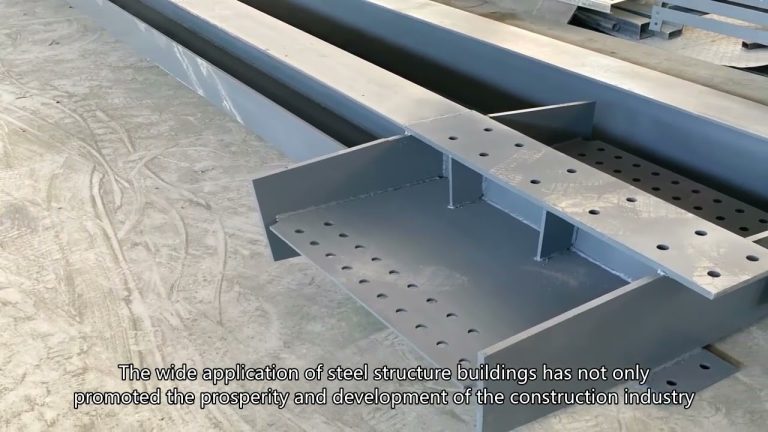Steel airport terminals the starting point for air travel
Inhoudsopgave
Sustainable Design Features of Steel Airport Terminals
Steel airport terminals are the backbone of air travel infrastructure around the world. These structures serve as the starting point for millions of passengers each day, providing a gateway to destinations near and far. In recent years, there has been a growing emphasis on sustainable design features in airport terminals, with steel emerging as a popular choice for its durability, versatility, and eco-friendly properties.
One of the key sustainable design features of steel airport terminals is their energy efficiency. Steel is a highly efficient material when it comes to heating and cooling, helping to reduce energy consumption and lower operating costs. This is particularly important in airport terminals, which are typically large, open spaces that require significant amounts of heating and cooling to maintain a comfortable environment for passengers and staff.
In addition to energy efficiency, steel airport terminals also offer excellent natural lighting opportunities. Steel structures can be designed to incorporate large windows and skylights, allowing natural light to flood the interior spaces. This not only reduces the need for artificial lighting during the day but also creates a more pleasant and welcoming environment for passengers. Natural light has been shown to have a positive impact on mood and productivity, making it an important consideration in the design of airport terminals.

Steel airport terminals are also highly adaptable and can be easily modified or expanded to accommodate changing needs. This flexibility is essential in the fast-paced world of air travel, where terminals must be able to adapt to fluctuating passenger numbers and evolving security requirements. Steel structures can be quickly and cost-effectively modified to meet these changing demands, ensuring that airport terminals remain functional and efficient for years to come.
Another important sustainable design feature of steel airport terminals is their recyclability. Steel is one of the most recycled materials in the world, with a recycling rate of over 90%. This means that steel airport terminals can be dismantled and recycled at the end of their lifespan, reducing the environmental impact of construction and demolition. By choosing steel for airport terminal construction, designers can help to minimize waste and conserve natural resources.
In addition to their sustainable design features, steel airport terminals also offer a number of practical benefits. Steel structures are incredibly strong and durable, able to withstand extreme weather conditions and heavy foot traffic. This makes them an ideal choice for airport terminals, which must be able to withstand the rigors of daily use and provide a safe and secure environment for passengers.
Overall, steel airport terminals are an excellent choice for sustainable and efficient air travel infrastructure. With their energy efficiency, natural lighting opportunities, adaptability, recyclability, and durability, steel structures offer a range of benefits that make them an attractive option for airport terminal design. As air travel continues to grow and evolve, steel airport terminals will play a crucial role in providing passengers with a safe, comfortable, and environmentally friendly starting point for their journeys.
Advantages of Using Steel in Airport Terminal Construction
Steel airport terminals are the backbone of air travel infrastructure around the world. These structures play a crucial role in facilitating the movement of millions of passengers and cargo each day. The use of steel in airport terminal construction offers a wide range of advantages that make it the material of choice for architects and engineers.
One of the key advantages of using steel in airport terminal construction is its strength and durability. Steel is known for its high tensile strength, which allows it to withstand heavy loads and harsh weather conditions. This makes steel airport terminals resilient to the wear and tear of daily operations, ensuring that they can continue to serve passengers for years to come.
In addition to its strength, steel is also a versatile material that can be easily customized to meet the specific design requirements of airport terminals. Steel can be shaped into various forms and sizes, allowing architects to create unique and innovative terminal designs. This flexibility in design is essential for creating functional and aesthetically pleasing airport terminals that enhance the overall passenger experience.
Furthermore, steel is a sustainable building material that offers environmental benefits. Steel is 100% recyclable and can be reused multiple times without losing its properties. This makes steel airport terminals a more sustainable option compared to other construction materials, reducing the environmental impact of airport development projects.
Another advantage of using steel in airport terminal construction is its cost-effectiveness. Steel is a cost-efficient material that offers a high strength-to-weight ratio, allowing for lighter and more efficient structural designs. This can result in lower construction costs and shorter construction timelines, making steel airport terminals a cost-effective solution for airport operators.
Moreover, steel airport terminals are easy to maintain and repair, reducing long-term maintenance costs. Steel structures are resistant to corrosion and deterioration, requiring minimal upkeep over their lifespan. This means that airport operators can save on maintenance expenses and allocate resources to other critical areas of airport operations.
In conclusion, steel airport terminals offer a wide range of advantages that make them the ideal choice for airport terminal construction. From their strength and durability to their versatility in design and sustainability, steel structures provide a solid foundation for air travel infrastructure. With their cost-effectiveness and ease of maintenance, steel airport terminals are a practical and efficient solution for meeting the growing demands of the aviation industry. As the starting point for air travel, steel airport terminals play a vital role in connecting people and goods around the world, ensuring the smooth and efficient operation of airports for years to come.








